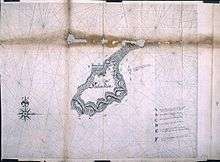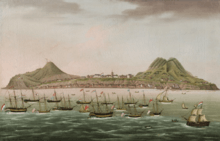Run (island)
Run (also known as Pulau Run, Pulo Run, Puloroon, or Rhun[1]) is one of the smallest islands of the Banda Islands, which are a part of the Moluccas, Indonesia. In 1616, fearing the Dutch, the natives of the island pledged their allegiance to the employees of English East India Company, who accepted it on behalf of the Crown. According to historian John Keay who considers Pulo Run as the genesis of the British Empire : "As the island of Runnymede is to British constitutional history, so the island of Run is to British imperial history".[2] In the 17th century, Run was of great economic importance because of the value of the spices nutmeg and mace.


Geography
Run is the westernmost of the Banda Islands, with a length of 3 kilometres (1.9 mi) and width of 1 kilometre (0.62 mi). The neighboring island of Pulau Ai is about 7 km east and the small islet of Pulau Nailakka is 700 m north..
History


During the history of the spice trade, sailors of the English East India Company of the second expedition of James Lancaster, John Davis, Sir Henry Middleton and his brother John who stayed in Bantam on Java, first reached the island in 1603 and developed good contacts with the inhabitants. A small settlement was first attempted on Pulau Nailakka.On December 25, 1616,[3] Captain Nathaniel Courthope and 1st mate Zachary Barnett Duncan reached Run to defend it against the claims of the Dutch East India Company. A contract with the inhabitants was signed, accepting James I of England as sovereign of the island. The Dutch were outraged over this threat to their monopoly on the extremely profitable spice trade. Courthope fortified the island by erecting forts to overlook approaches from the east, but lost two ships to mutiny and sinking by the Dutch, when they laid siege to the island. Courthope and 39 European defenders with their native allies held off the Dutch for 1540 days; however, after his death in a Dutch attack in 1620, the English departed the island. [4] Finally in possession of Run, the Dutch proceeded to kill or enslave all adult men, exile the women and children and chop down every nutmeg tree on the island to prevent the English from retaking it. The VOC only allowed cattle to roam free on Run to provide food for the other islands.[5] It was not until 1638 that the English tried to access Run again, after which VOC officials annually visited the island to check if they had secretly re-established themselves.
According to the Treaty of Westminster ending the First Anglo-Dutch War (1652-1654), Run should have been returned to England.
After the Second Anglo-Dutch War (1665-1667), England and the United Provinces of the Netherlands agreed in the Treaty of Breda to the status quo: the English kept the island of Manhattan, which the Duke of York (the future James II, brother of Charles II), had occupied in 1664, renaming the city on that island from New Amsterdam to New York. In return, Run was formally abandoned to the Dutch. The Dutch monopoly on nutmeg and mace was destroyed by the transfer of nutmeg trees to Ceylon, Grenada, Singapore and other British colonies in 1817, after the capture of the Spice islands in 1810 by Captain Cole, leading to the decline of the Dutch supremacy in the spice trade.[6] Dutch control of the island ended in 1949, but there are still nutmeg trees growing on Run today.
References
- The Spice Trail: 2, Nutmeg and Cloves (spelt Rhun on the map and also in subtitles)
- Keay 2010, p. 1.
- Ratnikas, Algirdas J. "Timeline Indonesia". Timelines.ws. Archived from the original on July 10, 2010. Retrieved 2010-08-12.
- Ratnikas, Algirdas J. "Timeline Indonesia". Timelines.ws. Archived from the original on 10 July 2010. Retrieved 2010-08-12.
- Loth 1995, p. 19.
- Amitav Ghosh (December 30, 2016). "What Nutmeg Can Tell Us About Nafta". New York Times.
Further reading
- Dotschkal, Janna (June 22, 2015). "The Spice Trade's Forgotten Island". National Geographic.
- Milton, Giles (1999). Nathaniel's Nutmeg (reissue, illustrated ed.). Penguin Books. ISBN 978-0-14-029260-2. OCLC 44871451.
External links
| Wikimedia Commons has media related to Run (island). |
- Keay, John (2010). The Honourable Company. HarperCollins Publishers. ISBN 9780007395545.CS1 maint: ref=harv (link)
- . Encyclopædia Britannica. 3 (11th ed.). 1911.
- The Spice Traders Forgotten Island